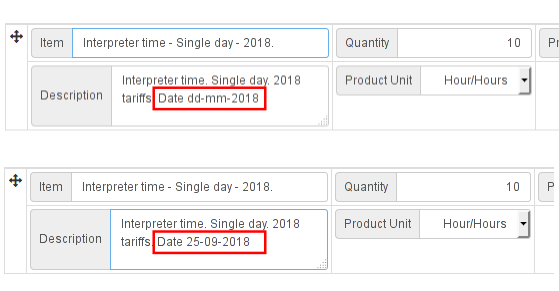Ich editiere eine Kopie von invoiceplane.php (das Rechnungstemplate).
In dem Bereich
<p class="einleitung">Somit stelle ich wie folgt in Rechnung:</p>
<div class="berechnung">
</div>
soll dann eine Tabelle rein, mit folgender Formatierung:
Einsatzdatum Einsatzdauer Fahrt- und Wartezeit Fahrtkosten Hin- & Rück Zwischensumme
15.10.2018 4 Stunden 2 Stunden 100€ xxxx €
Die Werte habe ich jeweils in einem Produkt hinterlegt. Ich habe also 4 Produkte angelegt.
Mit
<?php print_r($items); ?>
bekomme ich beispielsweise für die Einsatzdauer folgende Werte:
object(stdClass)
#295 (34) { [“item_amount_id”]=> string(2) “31”
[“item_id”]=> string(2)
“31”
[“item_subtotal”]=> string(6) “195.00”
[“item_tax_total”]=> string(4) “0.00”
[“item_discount”]=> string(4) “0.00”
[“item_total”]=> string(6) “195.00”
[“product_id”]=>
string(1) “1”
[“family_id”]=> NULL
[“product_sku”]=> string(0) “”
[“product_name”]=>
string(12) “einsatzdauer”
[“product_description”]=> string(10) “dd.mm.YYYY”
[“product_price”]=> string(5) “65.00”
[“purchase_price”]=> NULL
[“provider_name”]=>
string(0) “”
[“tax_rate_id”]=> NULL
[“unit_id”]=> NULL
[“product_tariff”]=> string(1) “0”
[“invoice_id”]=> string(1) “9”
[“item_tax_rate_id”]=> string(1) “0”
[“item_product_id”]=>
string(1) “1”
[“item_date_added”]=> string(10) “2018-10-08”
[“item_task_id”]=> NULL
[“item_name”]=> string(12) “einsatzdauer”
[“item_description”]=> string(10) “08.10.2018”
[“item_quantity”]=> string(4) “3.00”
[“item_price”]=> string(5) “65.00”
[“item_discount_amount”]=> NULL
[“item_order”]=> string(1) “1”
[“item_is_recurring”]=> NULL
[“item_product_unit”]=> NULL
[“item_product_unit_id”]=>
NULL [“item_date”]=> NULL
[“item_tax_rate_percent”]=> NULL
[“item_tax_rate_name”]=> NULL }
Aktuell hänge ich jetzt, wie ich am besten auf die bestimmten Werte, die ich oben geschrieben habe pro Produkt zugreifen kann und nicht, so wie usprünglich alles ausgeben kann. Danach das Produkt Fahrtzeit …
Gedacht hatte ich mir, dass ich nach der foreach-Schleife eine if-Schleife baue und dort prüfe, ob das Feld Datum gleich dem Description-Feldes ist. Falls ja, soll er dann in der Tabelle den Wert von item_quantity von der Einsatzdauer ausgeben.
Falls noch was unklar ist, einfach melden.


 )
)


